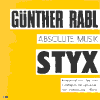Günther Rabl :: Renate Porstendorfer
STYX
 A
Fugue in Sounds and Images - Original Version from 1983 / 85
A
Fugue in Sounds and Images - Original Version from 1983 / 85
Photography and Screening: Renate Porstendorfer
Organizational Supervision: Thomas Gorbach
Technical Direction: Wolfgang Musil
Control Engineering: Georg Danczul
Setup: Richard Bruzek, Wagner Felipe dos Santos, Stephan Roth
Special thanks to: Christoff Wiesinger, Gilbert Handler, Katharina Klement
SAT, 12 December 9.00 p.m.
SUN, 13 December 8.00 p.m.
Kuppelsaal of the TU Wien
The Electroacoustic Project
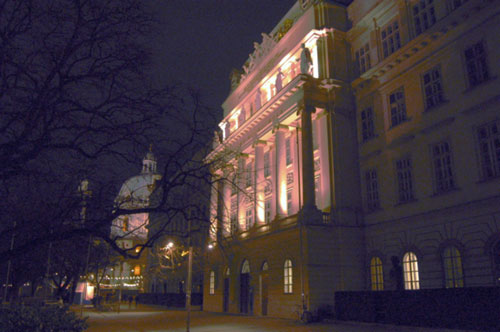
TU Wien Foto:Otto Jekel
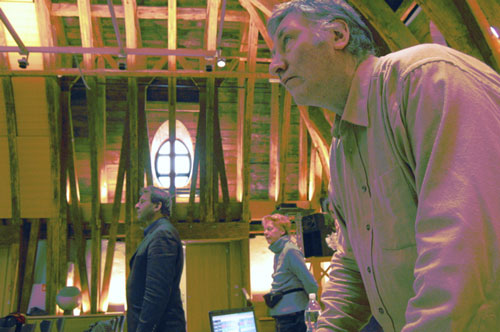
TU Wien Kuppelsaal
Wolfgang Musil, Renate Porstendorfer and Günther Rabl at rehearsal
(from l. to r.) Foto:Otto Jekel
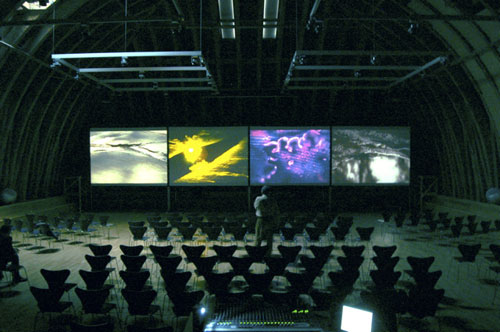
TU Wien Kuppelsaal Foto:Otto Jekel
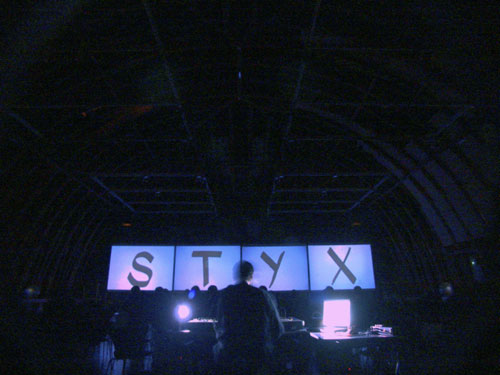
TU Wien Kuppelsaal Foto:Otto Jekel
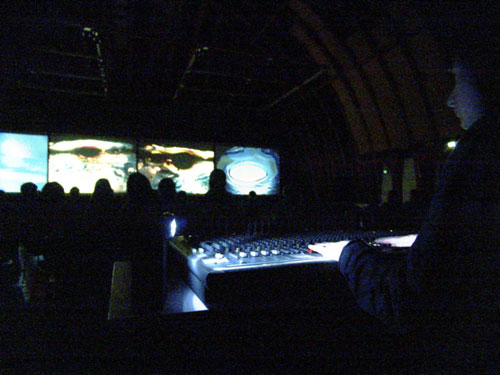
TU Wien Kuppelsaal Foto:Otto Jekel
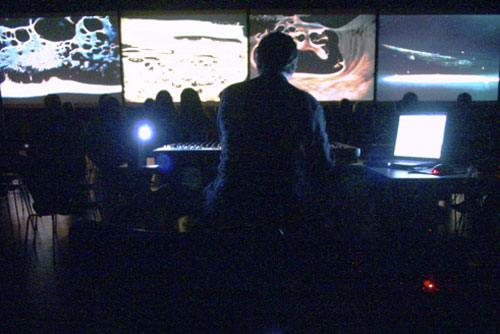
TU Wien Kuppelsaal Foto:Otto Jekel
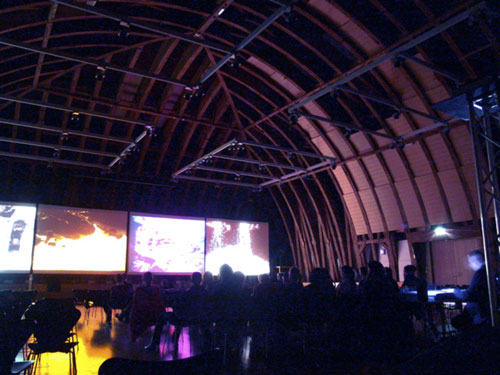
TU Wien Kuppelsaal Foto:Otto Jekel
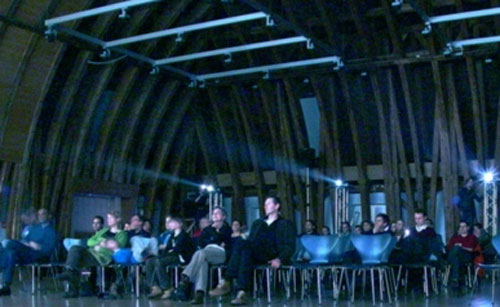
TU Wien Kuppelsaal Foto:Otto Jekel
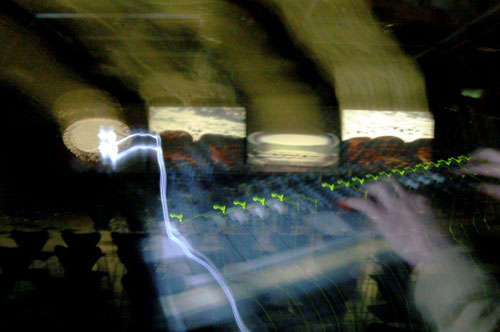
TU Wien Kuppelsaal Foto:Otto Jekel
Derived from five basic sources (fragments of outdoor recordings), generations of sounds and sonorous processes are produced in rising and falling order by a constant change of electronic transformation and construction.”
(Liner Notes from the first CD release, 1988)
In my preceding larger work ATEM (BREATH) (1981/82), I took the serial
composition process to extremes. Variations of rows that are derived
from the sound material itself determine all areas of the composition
– particularly the so-called “technical” parameters
that thereby become musically available.
In this systematic work, I again and again delved into sound realms
that had something special to them. At the intersection of electronic
transformation, sound types appeared that convey an authenticity that
one otherwise only knows from good recordings – with the advantage
that they do not have to refer to anything more than themselves (“recording
of ...”). What is amazing is that these sound forms appear to
be resistive against the methods that help make them detectable. They
cannot be explained by serial composition. Therefore, I largely avoided
them during the work on ATEM. (In my written records from that time
there is the following note: “With such sounds one can absolutely
not compose – or if so, then 24 hours of music – dream-ridden”).
In STYX, however, I took them up again. The condition was that one
has to get involved with their independent existence: Composing no longer
as an “ordering of tones,” but rather as a type of dramaturgy
of sound forms that tells their own story. Therefore, STYX traces an
arc back to my first audio tape pieces (MUGL ENTSTEIGT [MUGL ARISES]).
The most important design principle was the metamorphosis or, technically
stated: the electronic transformation. Although it would last years
until I had a computer with audio output, it was already clear that
one could expect unforeseen new processing methods. The anticipation
(and the corresponding theoretical preparatory work) spurned me on to
new combinations of already known processes. As a matter of fact, in
this work I anticipated some of the things that were generally available
much later with the emergence of faster processors – often in
hour-long processes with audio tapes and simple, but high-quality electronic
devices that Georg Danczul had constructed according to my ideas.
A new challenge was the design of the screen change. That means it
was not really so new after all, as in the previous years there was
a loose cooperation in the combination of improvisations, audio tape
feeds and slide projection, as well as a completely composed piece “Märchen”
(“Fairy Tale”), that is still audio-visually performable
today. However, there were four screens for the four sound channels
(that was clear from the beginning) and the contrapuntal screen change
afterwards was definitely a “musical” task.
While I was working on STYX, with interruptions, nonetheless, for two-and-a-half
years, Renate Porstendorfer took a series of photos independent of my
work. Partially in Waldviertel, partially in the Salzburg mountains,
on fields, at rivers, at waterfalls; many landscape pictures, but mainly
moments of moving water and light effects. In addition, there were microstructures
with glass and colored etches that often had a more graphic effect than
the images of real landscape elements. Moreover, there was an increasingly
more sophisticated handling of various film material. Thousands of pictures.
“I see outside of myself. What slumbers inside of me wordlessly
and imagelessly is perhaps already there on the outside. Looking, I
wait for the resonance of recognition. I only have to be permeable for
this. It must go through me and come onto the film. It must arrive.”
(R.P.)
As it became increasingly clearer that these images in the form of
projections can produce an optic level to STYX, fundamental decisions
had to be made. One of these was: cross-fading, yes or no. Similar as
in the music, I consider fade-ins, fade-outs and cross-fading to be
useful technical methods for pictures, but not to be formal solutions.
(Even today among us electroacoustic musicians, the “fade fader”
is a “running gag” when we hear old pop music songs that
have no other way out after three minutes than slowly pulling the volume
modulator down). Thus: rough transitions. The rhythmization of the screen
change took on a new significance. The combination of images, the lines
and levels of motifs and colors was Renate’s work for the most
part; the rhythmization was mostly mine.
Whoever has set a series of images or film to music knows that acoustic
time and optical time are not the same things. The same holds true for
the contents that are to be transported. At the beginnings of the talking
film, the Russian filmmakers like Vertov and Eisenstein established
the dogma that sound and film may never represent the same thing. Well,
I wouldn’t adopt this as a dogma, but it is true: One thereby
forgoes a whole dimension – just like one forgoes a dimension
when the image rhythm and the musical rhythm are flatly linked to each
other. Indeed there are relationships between individual images and
musical motifs, but their temporal coherence can greatly diverge –
looking forward, flashing back or syncopated. A precise concurrence
of the screen change and acoustic accent is reserved to very few dramatic
moments. Otherwise, the various narrative strands run parallel on several
levels and combine to make a single large epic bow, precisely to a fugue
in sounds and images.
G.R.
The premiere of STYX in the original version took place in December 1985 at Palais Erzherzog Karl in Vienna. Two further performances followed: one at the Konzerthaus Vienna in 1986, and one at the Munich Philharmonie in 1987. From then onwards, the piece was shown several times in Austria and Hungary in a reduced version with only one screen. The present version is a digitally reconstructed new synchronization of the music from the intermediary material, as well as the projector control of the original slides.
Appendix “Material”
Even for practitioners, it is not always comprehensible what I mean
by sound material. I see and use it actually as material in a manual
sense. Nonetheless, I am repeatedly asked the same question; yeah, which
types of recordings are being processed there. I stress once again that
they have no anecdotic meaning for the dramaturgy. It is not a radio
play, it is music. However, I don’t make a secret out of it.
Here they are:
1) A combine harvester driving up and down a field
2) A car horn
3) A fire siren at noon with church bells and swallows
4) A study of chords in third tones on the cello
5) A street scene with cars, tractors and playing children
With the exception of the combine harvester recording, which lasts a good half-hour, these fragments are relatively short. However, the intermediary material, and all the electronic transformations and developments from this original material are found on more than 50 audio tapes, making up a total of approximately 30 hours of sound.
translated by Brian Dorsey
